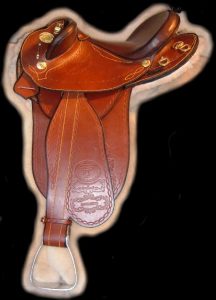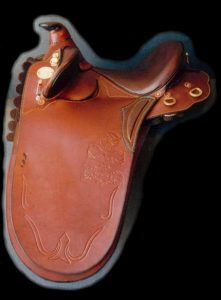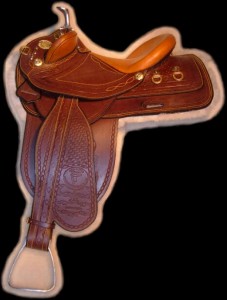IMPORTANT THINGS TO CONSIDER BEFORE CHOOSING A SADDLE:
1. Do you need a hair lined saddle or a fleece lined saddle
Hair lined or counter lined saddles have been in use in Australia pretty much since the country was first settled. Hair lined saddles do have some very good points eg hair can be added or removed to allow the saddle to fit different shaped horses. Another good point is that the hair lining of a new saddle will compact with use to take the shape of the average horse you are using it on. The downside of the hair lined saddle is that when you start stuffing hair into the under side of a saddle, it has a balloon effect and simply lifts the riders centre of gravity, along with the saddle. The surface area that makes contact with the horses back is relatively small when compared to say an American style saddle or a fleece lined Australian Stock Saddle. The main advantage of the fleece lined saddle is that it allows for a much closer contact saddle. The surface area on the horses back is much larger meaning less rider pounds per square inch and less chance of soring up a valuable horse and of course you don’t have the ongoing cost of counter lining that you have with a hair lined saddle. One of the comments I get from people considering a fleece lined saddle is that they seem fairly hard on the under side when compared to a hair lined saddle. However, if you look at a hair lined saddle after some use you will find that the compacted hair has become very hard as well. The point is that even thought it is hard the hair has compacted to the shape of the horse and despite the hardness no sore back problems or rubbing occurs. So provided your fleece lined saddle fits the horse you are using it on there wont be a problem. Remember though that a horse constantly changes shape depending on diet, the amount of exercise or work it gets and of course the ageing process also causes body change and bone calcification. It is up to you, the rider to constantly monitor your horses condition to make sure the saddle you ultimately choose still fits your ever-changing horse.
However, today’s popular saddle is the fleece lined saddle. It is close contact, less likely to sore up a horse and is maintenance free.
2. Do you need a horn on your saddle?
Horns on an Australian Stock Saddle are an option. however, unless the saddle is being adapted to rodeo work no one orders a saddle with a horn. It all comes down to the way cattle are worked. In the US cattle are roped and branded one at a time, for this you need a roping saddle with a horn.
In Australia the cattle properties are just too big and the cattle too many, so the cattle are initially herded with a helicopter into a desirable area and then into yards with horse or motorbikes. Once in the yards they are put through a race with a cradle at the end. They step into they cradle and they are locked into position. The cradle holding the cow pivots to any position to allow branding to be quickly and easily done.
The best saddle for roping is the American Western Saddle. It is long and the double girth system makes it hard to pull off a horse.
The horn on an Australian Stock Saddle is close to the rider to allow the rider to dally up or to wrap the rope around the horn. The horn gets in the way of the riders hand when he is trying to properly control the horse via the reins. If a rider is thrown even a little into the air, he or she can land on the horn. Mostly the horn causes stomach injury, but there are much more vulnerable areas of the human anatomy that are at risk of a very painful injury.
So the answer is horns in Australia just never get used unless for special purpose. These saddles hang onto you, you don’t need to hang onto it.
|
Fixed Horn
|
Detachable Horn
|
3. Do you need a fender or stirrup leather?
Australian Stock Saddles have traditionally had a stirrup leather 1 1/4″ wide. It has been mounted on a steel hook bar, which is a huge safety factor. If the rider falls and is being dragged, there is a good chance the stirrup leather would pull off the stirrup bar, thus releasing the rider being dragged. The narrow 1 1/4″ leathers were very flexible and allowed the rider great freedom of movement. The downside is that the leathers sometimes pinched and the buckles could rub on the inner leg. A wider 2″ leather became popular and did solve some of these problems. They were also stronger. It became apparent that the wider the leather, the more comfort and security was provided for the rider and the American style fender was introduced to the Australian Stock Saddle design. This proved to be a huge success. The fender when mounted on the stirrup bar still comes off if the rider falls and with the protection provided by the extra width of the fender you can virtually ride in shorts if you want to. The downside of the fender was that its width and wider 2 1/2″ straps made it very stiff and it would not move freely like the old style stirrup leather. Trevor James recognised this problem and designed a stirrup bar which is mounted on a steel roller bearing. The result is that the fender can now move freely to suit any rider style or unexpected situation. With this adaptation the fender is strong, provides rider protection and is absolutely friction free. It has been so successful that orders received by Trevor James these days are for fender saddles with the rotating stirrup bar. For more information on the rotating stirrup bar, click here.
Below – The narrower inch and a quarter stirrup leathers, which tend to pinch and the buckles can rub.
The wider fender, which fully protects the rider’s leg.
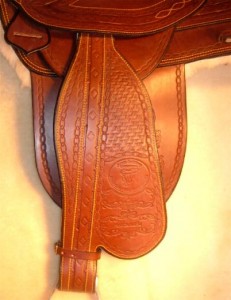
4. Do you need a sweat flap on your fleece lined saddle?
The Australian Stock Saddle has evolved into a fleece lined fender saddle, but the traditional Australian saddle has always had an under flap or a sweat flap. Competition riders often prefer close contact saddles to get a better feel of the horse. In order to do this, the under flap is often eliminated. To get even better contact sometimes the panel is cut away under where the fender is situated. The problem with this is that the area that is cut away is where the rigging D is situated. This means that the rigging D is often placed higher on the horses side or on the top side of the curve of the horses back. In this case when you girth up the position of the rigging D means you are exerting pressure in such a way as to try to break the ribs of the horses backbone. As the competition rider may only be riding for a few minutes at a time, these things may not represent a huge problem. However, if you are riding all day it is far better to keep the rigging D as far down the horses side as possible. This takes the pressure off the ribs at the point where they join the back bone. The under flap is also a huge bonus for horse and rider. Firstly it protects the horses side by allowing protection from the girth system and from friction caused by rider by movement.
The under flap when used on a fender saddle is a definite asset. Firstly the girth system passes over the under flap and thus protects your valuable horse. It prevents sweat from reaching the fender and protects the riders riding wear – jeans etc. Most importantly, it allows the fender to swing freely. Without an under flap your fender rubs against the grain of the horses hair growth, once again soring up a valuable horse.
5. Do you need a surcingle and a stirrup bar on your fender saddle?
Most fender saddles do not have a provision for a surcingle. This is because the panel construction is very strong and with the saddles designed by Trevor James the leather panels that hold the rigging D is reinforced with nylon webbing and this method of construction is second to none. The surcingle can also restrict fender movement, which is one of the key elements people are looking for in fender saddles. However, pony club rules specify that for very sound safety reasons a surcingle is essential along with a stirrup bar. Every saddle designed and made by Trevor James has a stirrup bar and a correctly positioned surcingle is available on any saddle fender or otherwise. Trevor recognises the importance of rider safety and the importance of these two distinctly Australian safety features.
* The ability of the fender to release from the stirrup bar if the rider falls and is being dragged.
* The security given by the surcingle. If the primary girth fails, the saddle is still securely held in place by the back up system known as the surcingle.
6. Is the weight of your new saddle important?
With the Australian Stock Saddle being recognised world wide as possibly the worlds safest and most secure . It has been adapted by many as their leisure trail ride or general purpose all round saddle. It was originally designed to withstand the rigors of the working Stockman on cattle stations in the Australian outback and as such was and is expected to give a minimum of 30 years of service is some of the harshest conditions on the planet. Remember some cattle properties reach a size of 10,000 square kilometers. The saddles designed and made by Trevor James still meet that criteria and it is quite a common occurance that saddles 20 – 30 years old are returned for minor maintenance work. However, people who have adopted the Australian Stock Saddle as their favourite pleasure or trail ride saddle for one reason or another may want a saddle that is much lighter than the traditional work saddles. Sporting riders and particularly endurance riders seek an advantage by having a lighter saddle. It is important to consider how the weight of a saddle is reduced. Firstly the leather used in saddles made by Trevor James is 4.2 mil thick and can be up to 4.5 mil thick. Trevor knows from decades of real life testing this leather will last 30 years or more if properly cared for. To make a lighter saddle, the leather thickness is usually reduced to 3.5 mil. By reducing the leather thickness by roughly 25% you reduce the weight of the leather in the saddle by 25%. Unfortunately you also reduce the life expectance of the saddle by 25%.
The next thing most saddle makers reduce the weight of is the saddle tree. Saddle trees for more than a century have been wood and steel. With the advent of modern products such as fibreglass and mouldable plasters etc. Wood and steel are very rarely used by Australian saddle makers today.
Trevor James uses his own design registered and in some cases patented tree constructions to make a light, thin, close contact saddle tree that is extremely strong. (Click here to see saddle tree guarantee.) These trees have been proven over millions of hours of real life testing and carry a ten year guarantee.
To reduce the weight of saddle trees is possible and methods of construction utilising carbon fibre can halve the weight of a tree, but increase the cost dramatically.
The weight of trees can be reduced by other methods. Attempts have been made to reinforce trees using aluminium instead of steel. Aluminium is one of the weakest metals available and if the stronger aluminium is used it eventually cracks and the trees fail. In most cases attempts to lighten saddle trees are strictly experimental and it is unfortunate that you, the buyer is the unwitting subject of these experiments that often end in tragedy.
The answer is yes, a saddles weight can be reduced, but only by reducing the strength of the tree, the thickness of the materials and ultimately the life expectancy, along with the strength and safety provided by the conventional saddles designed by Trevor James, which weigh around 10 kilos.
Remember the American legend, Seabiscuit won races carrying the Jockey Red Pollard. In some cases Mr Pollard weighed more than 30 lbs heavier than any other jockey in the race. Horses are immensely strong and resilient animals and the few kilos taken off a saddle would not make an ounce of difference or even be noticed by the horse.
7. Designing your own saddle – Click here for details
Please consider all of these important factors before deciding what best suits your particular requirements and those of your horse.
8. Do you want Sheepskin or Felt Lining?
Felt Lined Saddle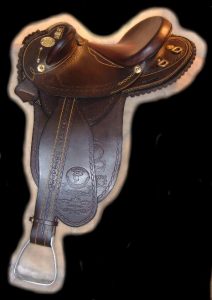
Sheepskin Lined Saddle